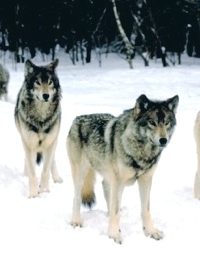
In March, Candice Berner, a 32-year-old schoolteacher, was killed by wolves near Chignik Lake, Alaska. In mid- August, members of Berner's family from Pennsylvania gathered on Three Star, a mountain near Perryville, Alaska for a memorial service for Candice. An AP story of the memorial gives the following brief account of the young teacher's last day alive:
Ms. Berner, a petite, accomplished athlete, who studied education at Slippery Rock University, was a special education teacher. She had just finished her day teaching at Chignik Lake, another of the small communities dotting the Alaska Peninsula, back on March 8 when she decided to go running on the road to the village airstrip.
Unbeknownst to Candice Berner, a pair of wolves was stalking that same road and, as the AP story recounts, "Ms. Berner, alone, unarmed, with headphones blocking all cues, became their instant prey. Area residents on a snowmachine who came down the road shortly thereafter saw blood on the road and found her body."
Wolf attacks on humans have been relatively rare over the past century in comparison, for example, to bear attacks. However, claims by environmental activists and their sympathizers in the major media that wolves never attack humans (and historically never, or very rarely, ever attacked humans) have been proven false by Candice Berner's fate. And the Berner case is not unique, as the following stories show: Ontario man killed in wolf attack, coroner's jury finds; Six injured in rare wolf attack;
Wolf Attacks on Humans (an historical survey); The Danger of Wolves to Humans.
Only days before Candice Berner's memorial, Judge Donald Molloy of the United States District Court in Missoula, Montana, ruled in favor of a coalition of extreme environmentalist and animal rights groups* that had challenged a wolf control program approved by the U.S. Fish & Wildlife Service (USFWS) and the states of Idaho and Montana. That program allowed hunters to take 220 wolves in Idaho and 75 in Montana. Those numbers were established by the state and federal wildlife officials as a modest attempt to trim the burgeoning wolf populations that are devastating wild elk herds, as well as other wild ungulates.
According to the Idaho Department of Fish & Game (IDFG) only 188 wolves were taken by hunters against the statewide harvest limit of 220 wolves in 2009. In Montana, 72 wolves were taken by hunters in 2009, out of the total permitted quota of 75.
The wolf hunt, predictably, set the enviro/animal rights litigants howling, notwithstanding the fact that the wolf population in Idaho alone is at least 1,000, which is ten times the total agreed upon by the same litigants and federal and state officials in 1994 of 10 breeding pairs and 100 wolves in each of the three states.
In an August 16, 2010 statement, the Idaho Fish and Game Commission noted:
In 1995 and 1996, 66 wolves were captured in southwestern Canada, with 35 released in central Idaho and 31 released in Yellowstone National Park. By 2000, the northern Rocky Mountain wolf population had expanded to include more than 30 breeding pairs and 300 wolves.
The Commission went on to report:
In 1995 and 1996, 66 wolves were captured in southwestern Canada, with 35 released in central Idaho and 31 released in Yellowstone National Park. By 2000, the northern Rocky Mountain wolf population had expanded to include more than 30 breeding pairs and 300 wolves.
The Commission further noted that in 2008 it had adopted a Wolf Population Management Plan "intending to manage wolf populations at the 2005 level (518 wolves), being in excess of five times the 10 breeding pairs and 100 wolves required for Idaho under the federal recovery goals."
Deceit, Fraud, and Federal Felons
However, even after exceeding by five times the originally agreed-upon goal, federal and state officials, together with the powerful environmental lobby, pressed on for more. Officials now give a minimum estimate of 1,700 wolves in the three-state recovery area. But as we have previously reported, (NatGeo’s “Wolf Wars” Flacks for Radical Greens and Wolves Will Thrive Despite Recent Hunts) many experts believe those statistics are suspect, and reputable wildlife biologists estimate the real wolf totals are much higher, perhaps as high as 3,000 — or more.
Even so, Defenders of Wildlife and their colleagues have upped the ante and are now saying that a wolf population of 5,000, or even 6,000 is now needed in the three-state area that they initially said would only be allowed to reach a total 300 wolves.
Critics of the ever-escalating wolf population proposals charge that government officials and green activists are colluding in a deceptive campaign of "keep-moving-the-goal-line" politics. But it is even more serious than that say others, including Jim Beers, a former USFWS wildlife biologist with more than three decades of experience in federal and state agencies. Among the many charges Mr. Beers levels against federal employees in his May, 2010 study, "Criminal Activities by Federal Bureaucrats and Others Involved in the Introduction, Protection and Spread of Wolves in the Lower 48 States," are these:
— theft (misappropriation, diversion) and misuse by USFWS Administrators of at least $60 Million;
— Introducing wolves from Canada into Yellowstone National Park after the U.S. Congress had refused to Appropriate funds for or to Authorize such action;
— Failure to file Wildlife Importation Forms (Form 3-177) upon importing wolves from Canada into the United States for release soon thereafter in Yellowstone National Park;
— Using tax money to bribe a witness aware of government theft of funds to keep quiet.
Survival of Elk, Other Big Game Ungulates at Stake
The Rocky Mountain Elk Foundation (RMEF) is calling for immediate congressional review and reform of the Endangered Species Act following Judge Molloy's decision to reinstate full federal protection for gray wolves. The ruling means, says the Foundation, that state wildlife agencies no longer have authority to manage skyrocketing wolf populations — even in areas where wolf predation is driving cow elk, moose and elk calf survival rates below thresholds needed to sustain herds for the future. RMEF says Judge Molloy "has opened a door for perhaps the greatest wildlife management disaster in America since the wanton destruction of bison herds over a century ago."
"When federal statutes and judges actually endorse the annihilation of big game herds, livestock, rural and sporting lifestyles — and possibly even compromise human safety — then clearly the Endangered Species Act as currently written has major flaws," said David Allen, RMEF president and CEO.
The decline in the Greater Yellowstone's elk population since the reintroduction of wolves in 1995 has been greater than was originally predicted. In the three winters prior to the reintroduction of wolves, elk on Yellowstone's northern range numbered roughly between 17,000 and 19,000. In the three winters prior to 2008, annual elk counts had declined to between 6,738 and 6,279.
Other areas have been similarly devastated by wolf predation. Perhaps the worst-hit areas have been the Lolo Wildlife Management Zones 10 and 12 in the Clearwater River watershed in Idaho. Citing herd data from the Idaho Department of Fish & Game, SaveElk.com has noted that in Zone 10 the number of cow elk has declined from 7,692 in 1989 to 824 in 2010, or 89 percent. In Zone 12 the number of cows has declined from 3,059 in 1986 to 534 in 2010, or 83 percent.
Equally calamitous, in Zone 10 the number of elk calves has declined from 2,298 in 1989 to 144 in 2010, or 94 percent. In Zone 12 the number of calves has declined from 856 in 1985 to 38 in 2010, or 96 percent.
"Clearly, the elk populations have crashed in these zones," says SaveElk.com, and, clearly, "the reason for the elk population crash is not hunting."
SaveElk.com points out that all the elk taken by hunters in Zones 10 and 12 are bulls, and "that does not affect population dynamics as explained above. Furthermore, Lolo zone elk harvest [by hunters] has also declined precipitously, from over 1,500 in 1989 to less than 150 in 2008 in Zone 10 and from nearly 600 in 1992 to less than 100 in 2008 in Zone 12."
"The principal reason for the crashing elk populations," says SaveElk.com "is undoubtedly the introduction of wolves in 1995, and the subsequent explosion of the wolf population."
The statistics tell an alarming story. But to them should be added the photographic evidence of the grim slaughter of the once-populous deer and elk herds, which can be seen here, here, and here.
Photographs showing the massive size that the imported Canadian gray wolves are capable of attaining can be seen here and here, providing sobering confirmation of critics' warnings that these formidable predators are not exactly the cute, cuddly creatures their advocates claim they are; they are, instead, an alien species that has been thrust into a new ecosystem and allowed to proliferate with unnatural protection to the point that they present a serious danger to all other species of fauna, the human species included.
__________
*The members of the coalition of radical environmental groups that have challenged the wolf hunts with lawsuits in federal court include: EarthJustice, Defenders of Wildlife, Natural Resources Defense Council, Sierra Club, Center for Biological Diversity, The Humane Society of the United States, Jackson Hole Conservation Alliance, Friends of the Clearwater, Alliance for the Wild Rockies, Oregon Wild, Cascadia Wildlands, Western Watersheds Project, Wildlands Project, and Hells Canyon Preservation Council.
Related Content:



